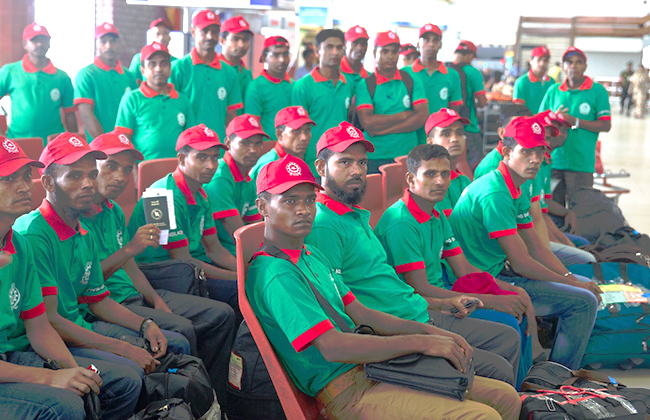
Key findings of a recent report of the International Organization for Migration (IOM) indicate that in the months after the government lifted the nationwide lockdown, more returnees were able to find jobs, reports of health and psychosocial challenges declined, household-level food access or food security improved.
However, household debt had increased and migrant households were adopting negative coping measures including reducing expenditure on health and borrowing money to pay back loans.
The findings from the second round of data collection are presented in the report, ”Rapid Assessment Round 2: Needs and Vulnerabilities of Internal and International Return Migrants in Bangladesh”.
The latest round of data collection was completed in August and September, 2020 in 12 high return-migration districts in Bangladesh.
A total of 1,584 respondents, including 875 international return migrants and 709 internal return migrants, took part.
In June 2020, IOM interviewed 2,765 internal and international migrant workers that had returned to Bangladesh and then re-interviewed 1,584 of the respondents three months later.
The findings provide stakeholders with an understanding of the socioeconomic impacts of the crisis, the challenges migrants face with reintegration and the importance of building back the resilience of migrant communities.
The findings indicate that there was a 20 per cent increase of international returnees who reported that they were facing challenges (round one – 50 per cent; round two 71 per cent).
The most prevalent primary challenges reported were difficulty in finding a job (47%), financial problems (29%) and repayment of debt (21%).
Among the respondents available for round two survey the unemployment rate dropped to 64 per cent.
Among the same respondents the unemployment rate was 74 per cent in May to June 2020.
The decline in unemployment may be attributed, at least partially, to the easing of lockdown measures at the end of May and the lifting of general business curfews and other restrictions at the beginning of September. Nevertheless, unemployment among respondents remained high.
The number of international returnee households reportedly eating three meals a day increased from June to September by 18 per cent and by 43 per cent to 92 per cent for internal returnee households.
The findings indicate that international returnees, who were unable to secure jobs, were more likely to apply for government assistance (60%) than internal returnees (39%).
Both internal and international migrants reported borrowing money, reducing expenditures, and depending on donations to cope with financial issues and to repay debt.
In the face of financial problems, returnees coped by borrowing money or taking out additional loans (50 per cent of international return migrants and 71 per cent of internal migrants).
More than half of respondents that had returned from abroad reported debts of over BDT 100,000 while 28 per cent reported debts of over BDT 200,000.
A total of 58 per cent of international returnees and 53 per cent of internal returnees indicated that their debts had increased from June to September 2020.
Giorgi Gigauri, Chief of Mission of IOM in Bangladesh, said, “We are living through an unprecedented crisis and in order to recover better and faster, we need research to better understand how communities coped with unemployment and lockdowns and what their migration aspirations are.”
Gigauri said the information from research will help them strengthen support systems to provide migrant workers protection against future outbreaks of international concern.
“The findings of our study support global indications that the COVID-19 pandemic has disproportionately impacted people on the move.”
”We recognize the value of migrants to communities in Bangladesh and overseas. IOM is committed to supporting the Government of Bangladesh to better plan migration management and sustainable reintegration of returning migrants. We need to work together to ensure that we meet the needs of migrant workers from/in Bangladesh”, he added.
The number of respondents wishing to return abroad remained high (78%) and the most popular intended countries of destination were India, Saudi Arabia, the United Arab Emirates, Oman, Italy and Malaysia.
There was a decrease in certainty of timelines for remigration abroad and respondents reported this was due to the ongoing uncertainty regarding visas and vaccine access, restrictions on international travel, and the cost of travel.
In comparison, there was a 10 percent decline in respondents reporting they wanted to migrate internally and of the total (75%), almost half indicated that they would choose to move to Dhaka (47%), while Chattogram (15%) and Barisal (13%) were the next most popular destinations.
The ”Rapid Assessment Round 2: Needs and Vulnerabilities of Internal and International Return Migrants in Bangladesh” was conducted under the EU-funded project ‘Regional Evidence for Migration Analysis and Policy (REMAP)’ and the report is available to download here.


